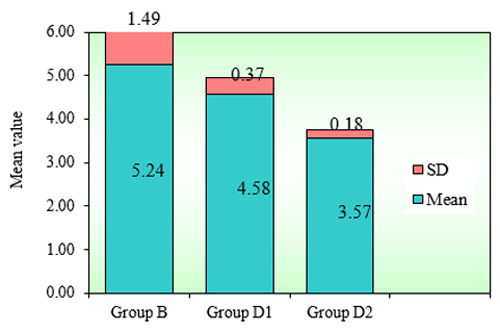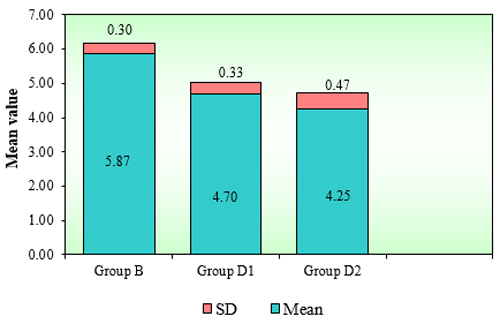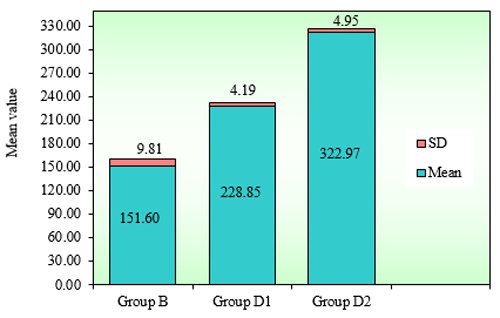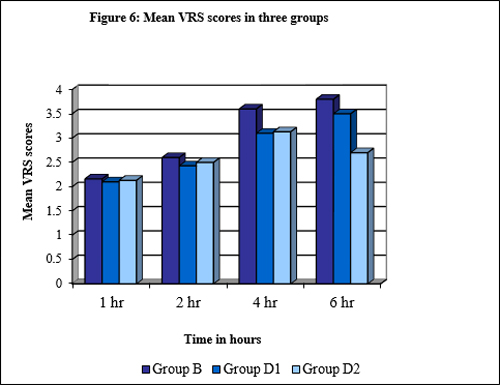Safiya I. Shaikh*, Rohini Dattatri**
*Professor & Head; **Postgraduate student
Department of Anesthesiology, Karnataka Institute of Medical Sciences, Karnataka (India)
Correspondence: Professor Safiya I. Shaikh, Head, Department of Anaesthesiology, Karnataka Institute of Medical Sciences, Karnataka (India); Phone: 0836-2740937; CELL: 09448861706; E-mail: ssafiya11@yahoo.com
ABSTRACT
Aims & Objectives: Various adjuncts have been used with local anesthetics in spinal anesthesia to provide good quality of intra-operative and better post-operative analgesia. Dexmedetomidine is a new α-2 adrenergic agonist, now being used as a neuraxial adjuvant.
The aim of our study was to investigate the effect of intrathecal administration of dexmedetomidine 5 µg and 10 µg, as an adjuvant to bupivacaine 0.5%, on the onset and duration of sensory and motor block, the hemodynamic effects, the duration of analgesia and the occurrence of side effects.
Methodology: This prospective randomized double blind study included 90 patients. Patients were randomly allocated into three groups of 30 patients each. Group B received 15 mg of 0.5% hyperbaric bupivacaine with normal saline, group D1 received 15 mg of hyperbaric bupivacaine with 5 µg and group D2 received 15 mg of hyperbaric bupivacaine with 10 µg of dexmedetomidine with normal saline to a total volume of 3.5 ml.The onset and duration of sensory and motor block, the hemodynamic effects, the duration of analgesia and the occurrence of side effects were noted.
Results: The mean time taken for the sensory block to reach T10 dermatome and motor block to reach Bromage 3 grade was significantly rapid in D1 and D2 groups as compared to bupivacaine group. The time taken for regression of sensory block to S1 dermatome and Bromage 0 motor block and the time to first rescue analgesic were increased significantly by addition of dexmedetomidine in a dose dependent manner.
Conclusion: Dexmedetomidine added to hyperbaric bupivacaine intrathecally has a dose dependent favorable effect on the onset and regression of sensory and motor block.
Key words: Spinal; Dexmedetomidine; Bupivacaine
Citation: Shaikh SI, Dattatri R. Dexmedetomidine as an adjuvant to hyperbaric spinal bupivacaine for infra-umbilical procedures: A dose related study. Anaesth Pain & Intensive Care 2014;18(2):180-185
INTRODUCTION
Pain is inherent to all surgeries causing significant morbidity. Perioperative pain management has been a major challenge for anesthesiologists and there has been a constant struggle to bring out the best possible analgesic technique with least side effects.
Regional anesthesia and analgesia has the potential to provide excellent operating conditions and prolonged post operative pain relief.1 It is also known to reduce post-operative morbidity and mortality by its positive influence like improved blood flow and optimum tissue functionality and improved recovery, thereby leading to its widespread use.2
Among all the regional techniques, subarachnoid block is still the first choice especially for below umbilical procedures because of its simplicity, rapid onset of action, less failure rate, cost-effectiveness, and superior level of blockade. However, post-operative pain control is a major problem because spinal anesthesia using only local anesthetics is associated with relatively short duration of action and thus early analgesic intervention is needed in post-operative period.3
Various adjuncts such as benzodiazepines, opioids, ketamine, neostigmine and many other drugs have been used with local anesthetics to provide better post-operative analgesia, thereby facilitating rehabilitation and accelerating functional recovery.4 But these adjuvants (especially opioids) are associated with side effects like pruritus, respiratory depression, urinary retention, post-operative nausea and vomiting which limit their use.
Hence,intrathecal α-2 agonists like clonidine are used as adjuvants to local anesthetics to potentiate the effects of local anesthetics and allow a decrease in required doses without causing respiratory depression.5 Intrathecal α-2 adrenergic agonists have anti-nociceptive action for both somatic and visceral pain.6 Dexmedetomidine is new alpha-2 agonist that was approved by FDA in 1999, for use in humans as a short term medication for sedation/analgesia in the intensive care unit.
Dexmedetomidine is a S-enantiomer of medetomidine with a higher specificity for α-adrenoceptor (α2:α1, 1620:1) compared to clonidine (α2:α1, 220:1). It is highly selective α-2 adrenergic agonist possessing hypnotic, sedative, anxiolytic, sympatholytic, opioid-sparing and analgesic properties without producing significant respiratory depression.7It acts by inhibiting the release of nor-epinephrine at locus coeruleus. Small doses of dexmedetomidine (3 µg) used in combination with spinal bupivacaine produces a shorter onset of motor block and a prolongation in the duration of motor and sensory block with preserved hemodynamic stability and minimal side effects.8,9 The enhanced anti-nociceptive effect is said to be related to its lipophilicity.10
With this in mind, this study is conducted to investigate the effect of intrathecal administration of dexmedetomidine on the duration of sensory and motor block, as well as the hemodynamic changes and the level of sedation.
METHODOLOGY
This prospective randomized double blind study was conducted at our institution for one year, from 1st January 2012 to 31st December 2012. After obtaining ethical committee approval from ethical committee, and informed consent, 90 adult patients, age group 18-60 yr, ASA I and II physical status scheduled to undergo various urological, gynecological or orthopedic procedures under spinal anesthesia were enrolled. Patients on antiarrhythmics, beta blockers, anticoagulants, ACE inhibitors, pregnant women, body weight >100 kg or height <150 cm were excluded from the study. Routine monitors like NIBP, pulse oximetry, ECG were connected. Baseline blood pressure, heart rate and respiratory rate were noted. Peripheral I.V. line was secured with 18 G cannula. Following infusion of 15 ml/kg of ringer lactate solution and under aseptic preparation, lumbar puncture was performed at L3-L4 position in patient in sitting or lateral position by midline approach after the local infiltration with 2% lignocaine using a 25G Quincke spinal needle.
Patients were randomized into three groups B, D1 and D2 of 30 patients each using sealed envelope technique. The dose of 0.5% hyperbaric bupivacaine 15 mg (3 ml) was identical in all study groups. Group B received 3 ml of 15 mg of heavy bupivacaine + 0.5 ml of 0.9% normal saline to a total volume of 3.5 ml. Group D1 received 3 ml of 15 mg of heavy bupivacaine + 0.5 ml of 5 µg of dexmedetomidine with 0.9% saline to a total volume of 3.5 ml. Group D2 received 3 ml of 15 mg of 0.5% heavy bupivacaine + 0.5 ml of 10 µg of dexmedetomidine with 0.9% saline to a total volume of 3.5 ml. The intrathecal drug formula was prepared by a separate anesthesiologist under a sterile technique who was blinded to the study. No pre-medication was given. Pulse rate, blood pressure and respiratory rate were monitored every 5 min for the first 15 min, then every 15 min for 1 hr, every 30 min for the next 2 hours, and every hour for the next three hours.
For the purpose of the study, hypotension was defined as a fall of SBP >20% from the baseline or <90 mmHg and was treated with inj. ephedrine 5 mg or mephentermine 6 mg. Bradycardia was defined as HR <50 beats/min and was treated with inj. atropine 0.3-0.5 mg. Respiratory depression (rate <10 bpm) was noted and if occurred was treated with oxygen supplementation and respiratory support if needed.
The sensory dermatome level was assessed by pin-prick sensation using 23G hypodermic needle along the midclavicular line bilaterally. The motor dermatome level was assessed according to modified bromage scale. Time taken for sensory block to reach T10 dermatome and motor block to Bromage 3 grade before surgery were noted. The time for sensory block regression to S1, motor block regression to Bromage grade 0 noted. Sedation was assessed at 60 min intra-operatively using Ramsay sedation score. Pain was assessed by verbal rating scale (VRS ) at 1st, 2nd, 4th and 6th hours post-operatively where patients were given a scale marked from 0 to 10 and were asked to mark the degree of pain experienced ranging from ‘No pain’ at 0 to ‘Maximum pain’ at 10 point. At VRS > 4, inj. diclofenac 75 mg IM was given as rescue analgesic and study ended. Duration of analgesia measured from the time of intrathecal injection to the first request of analgesia [VRS > 4] was monitored. Incidence of side effects like nausea, vomiting, hypotension, bradycardia and shivering were noted.
The statistical analysis of data was done by using statistical package for social science (SPSS) evaluation version 20. Data were expressed as either mean and standard deviation or numbers and percentages. The demographic data of the patients were studied for each of the three groups. Continuous covariates (age, duration of surgery, height, weight) were compared using analysis of variance (ANOVA). For categorical covariates (gender, ASA class) , Chi-square test was used with p-value reported at 95% confidence interval. For the time to reach T10 dermatome, Bromage 3 scale and regression of block to S1 dermatome and Bromage 0, time taken to rescue analgesia ANOVA test followed by Tukey’s multiple post-hoc test was used. The level of significance used was p< 0.05.
RESULTS
There was no significant difference in the demographic data of the patients in between the 3 groups (p>0.05) (Table 1).
Table 1: Demographic data (Mean ± S.D)
|
Parameter |
Group B |
Group D1 |
Group D2 |
P value |
| Age(years) |
34.37 ± 9.01 |
35.17 ± 11.15 |
35.16 ± 11.55 |
>0.05 |
| Male |
17 |
18 |
20 |
|
| Female |
13 |
12 |
10 |
|
| ASA 1 |
27 |
26 |
28 |
|
| ASA 2 |
3 |
4 |
2 |
|
| Weight (kg) |
58.93 ± 8.22 |
56.73 ± 7.52 |
58.56 ± 8.7 |
|
| Height (cm) |
165.30 ± 3.41 |
164.33 ± 3.58 |
164.1 ± 4.38 |
Regarding the incidence of side effects, two patients in group B , one patient each in Groups D1 and D2 had PONV. One patient in Group B had shivering. One patient in group B and group D2 each had bradycardia requiring atropine. Two patients in group B and one each in groups D1 and D2 had hypotension. No incidences of respiratory depression were noted. There were no statistically significant differences observed in the three groups (Table 2).
Table 2: Incidence of side effects
|
Side effects |
Group B N (%) |
Group D1 N (%) |
Group D2 N (%) |
Total |
| Nausea, vomiting |
2(6.66) |
1(3.33) |
1(1.33) |
4(13) |
| Shivering |
1(1.33) |
0 |
0 |
1(3.33) |
| Hypotension |
2(6.66) |
1(3.33) |
1(3.33) |
4(13) |
| Bradycardia |
1(1.33) |
0 |
1(1.33) |
2(4.44) |
Time taken to reach T10 dermatome is shown in Figure 1. The mean time for sensory block to reach T10 was 5.24±1.49 min, 4.58 ± 0.37 min and 3.57 ± 0.18 min in groups B, D1 and D2 respectively. Tukey’s multiple posthoc procedure showed that Group B vs. Group D1 (p<0.05), Group B vs. Group D2 (p<0.01), and Group D1 vs Group D2 (p<0.01) were significant.
Time for motor block to reach Bromage 3 is shown in Figure 2.The time observed was 5.87 ± 0.3 min in Group B, 4.70 ± 0.33 min in group D1 and 4.25 ± 0.47 min in group D2. Group B vs. Group D1, Group B vs. Group D2 and Group D1 vs. Group D2 by Tukey’s posthoc test were significant.
Figure 3 shows time taken for sensory regression to S1. The addition of dexmedetomidine resulted in a dose dependent prolongation of sensory regression to S1 segment. The prolongation in time to regress in Group B vs. group D1, Group B vs. D2 and D1 vs. group D2 was highly significant statistically by Tukey’s test (p<0.01).
Motor block regression to Bromage 0 is shown in Figure 4. Group D2 had a significantly prolonged motor block than groups D1 and B (Group B vs. Group D2, Group D1 vs. Group D2, p<0.05). Similarly, it was prolonged in Group D1 as compared to Group B (p<0.05).
Statistical analysis by ANOVA test and Tukey’s test showed that the time to first analgesic rescue was significantly prolonged in Group D2 and Group D1 as compared to Group B. Similarly, it was prolonged significantly in Group D1 as compared to Group B (Figure 5).
Regarding VRS score at 4th and 6th post-operative hours Group D2 had lower pain scores as compared to Groups D1 and B .Similarly, Group D1 had lower pain score as compared to Group B (Figure 6).
Sedation was assessed by Ramsay sedation score .2 patients (6.66%) in group B, 1 patient (3.33%) each in Groups D1 and D2 had a sedation score of 1.28 patients (93.3%) in group B, 29 patients (96.6%) in Groups D1 and D2 had a sedation score of 2. Statistical analysis
Figure 1: Time to Sensory block to reach T10 level
Figure 2: Time to reach motor block Bromage grade 3
Figure 3: Time to reach S1 dermatome
Figure 4: Time to reach Bromage 0
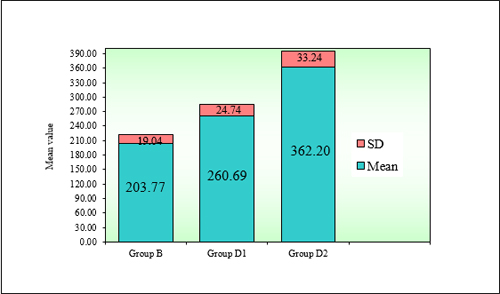
Figure 5: Time to rescue analgesia
showed that there was no significant difference in the sedation scores achieved between the 3 groups (p=0.77).
The heart rate, blood pressure, respiratory rate assessed at various time intervals showed no statistically significant differences. Episodes of hypotension and bradycardia were treated with inj. mephenteramine 6mg and inj. atropine 0.3mg respectively.
DISCUSSION
Various adjuvants like epinephrine, phenylepherine, adenosine, magnesium sulfate, fentanyl, ketamine and clonidine have been used as adjuncts to local anesthesia to avoid intraoperative visceral and somatic pain and to provide prolonged post-operative anesthesia. But these adjuvants are associated with various side effects thereby limiting their use. Hence intrathecal α-2 agonists like clonidine are used as adjuvants to local anesthetics to potentiate the effects of local anesthetics and allow a decrease in required dose without causing respiratory depression.5 Intrathecal α-2 adrenergic agonists have antinociceptive action for both somatic and visceral pain.6
Dexmedetomidine is an alpha-2 agonist and it was approved by FDA in 1999 for use in humans as a short term medication for sedation/analgesia in the intensive care unit.
The mechanism by which intrathecal α-adrenoceptor agonists prolong the motor and sensory block of local anesthetics is not well known.11 It may be an additive or synergistic effect secondary to the different mechanism of action of the local anesthetic. The local anesthetic acts by blocking sodium channels whereas α-adrenergic agonists are said to act by binding to pre-synaptic C-fibres and post-synaptic dorsal horn neurons. Their analgesic action is a result of depression of the release of C-fiber transmitters and hyperpolarisation of post-synaptic dorsal horn neurons and prolonged motor block might be caused by direct impairment of excitatory amino acids release from spinal interneurons.12
A small intrathecal dose of dexmedetomidine (3 µg) used in combination with bupivacaine for spinal anesthesia has been shown to produce a shorter onset of motor block and prolongation in the duration of motor and sensory block with hemodynamic stability and lack of sedation.9
In this study, addition of dexmedetomidine (5 µg and 10 µg) to hyperbaric bupivacaine intrathecally produced a rapid onset of sensory and motor block, prolonged the sensory and motor block and the time to first analgesic requirement significantly in a dose dependent manner. It also maintained stable hemodynamics with minimal side effects. Results of the current study concur with the results obtained by Al-Mustafa MM et al,11 Tarbeehet al13 and Jamliya RH et al,14 who found that dexmedetomidine has a dose-dependent effect on the onset and regression of sensory and motor block and the time to rescue analgesia with lower VAS scores and minimal side effects when used as an adjuvant to spinal bupivacaine.
A study by Shukla D et al15 concluded that there was no significant difference in the mean values of heart rate and mean arterial pressures between dexmedetomidine group (10 µg) and plain bupivacaine group. Administration of an α-2 agonist via an intrathecal or epidural route provides an analgesic effect without severe sedation. This effect is due to sparing of supraspinal CNS sites from excessive drug exposure, resulting in robust analgesia without heavy sedation.16 In our study there was no statistically significant differences in the sedation scores between three groups.
The result of this study is in contrast to the result obtained by Sunil BV et al17 who found that the sedation score was significantly higher in dexmedetomidine group (5 µg, 10 µg and 15 µg) as compared to plain bupivacaine group. The possible explanation was that they had premedicated all the patients with oral diazepam.
The main limitation of the study was that it involved only healthy adults and the effect in older patients with cardiovascular morbidities is not known. Secondly, total analgesic consumption in 24 hours was not noted.
CONCLUSION
On the basis of our study we conclude that addition of dexmedetomidine to hyperbaric bupivacaine intrathecally produces a rapid onset of sensory and motor block prolongs the sensory and motor block and the time to first analgesic requirement significantly in a dose dependent manner together with stable hemodynamic parameters, and minimal side effects.
Dexmedetomidine seems to be an attractive adjuvant to spinal bupivacaine especially in surgical procedures of long duration as an alternative to epidural or prolonged general anesthetics and can preclude intravenous anesthetics.
Conflict of interest: None declared by the authors.
1st author (SIS)responsibility/contribution: Concept, designing, conduct of study, analysis
2nd author (RD) responsibility/contribution: Conduct of the study, manuscript writing, literature search
REFERENCES
- NJH Davies, JN Cashman. Techniques in regional anaesthesia. Lee’s Synopsis of Anaesthesia. 13th ed. Elsevier, 2006; 401-70.
- Kettner SC, Willschke H, Marfoher P.Does regional anaesthesia really improve outcome. Br J Anesth 2011:201:91-95. [PubMed][Free Full Text]
- Gupta R, Verma R, Bogra R, Kohli M, Raman R, Kushwaha JK. A comparative study of intrathecal dexmedetomidine and fentanyl as adjuvants to bupivacaine. J Anaesth Clin Pharmacol. 2011;27:339-43. [PubMed][Free Full Text]
- Isguzar O, Bans S, Bozkurt A, Can B, Bilge S, Ture H. Evaluation of Antinociceptive and Neurotoxic Effects of Intrathecal Dexmedetomidine in Rats. Balkan Med J 2012;29:354-58. [Journal Abstract]
- Bakshi U, Chatterjee S, Sengupta S , Gupta D. Adjuvant Drugs In Central Neuraxial Analgesia- A Review. The Internet J Anesthesiol. 2009;26. [Access Online]
- Shah A, Patel I, Gandhi R. Haemodynamic effects of intrathecal dexmedetomidine added to ropivacaine intraoperatively and for postoperative analgesia. Intl J Basic Clin Pharm 2013;2:26-9. [Free Full Text]
- Tufanogullari B , White PF , Peixoto MP , Kianpour D , Lacour T , Griffin J et al. Dexmedetomidine infusion during laproscopic bariatric surgery; The effect on recovery outcome variables. Intl Anesth Res Society 2008;106:1741-48. [PubMed]
- Abdel Hamid SA, El-lakany MH. Intrathecal dexmedetomidine: useful or not? J Anesth Clin Res 2013;4:1-5.
- Al-Mustafa MM , Badran IZ , Abu-Ali HM ,Al-Barazangi BA , Massad IM , Al-Ghanem SM. Intravenous dexmedetomidine prolongs bupivacaine spinal analgesia. Middle East J Anesthesiol 2009;20:225-31. [PubMed]
- Ishii H , Kohno T , Yamakura T , Ikoma M , Baba H. Action of dexmedetomidine on the substantia gelatinosa neurons of the rat spinal cord. Eur J Neuro sci 2008;27:3182-90. [PubMed][Free Full Text]
- Al-Mustafa MM, Abu-Halaweh SA, Aloweidi AS, Murshidi MM, Ammari BA, Awwad ZM, et al. Effect of dexmedetomidine added to spinal bupivacaine for urological procedures. Saudi Med J. 2009;30:365-70. [PubMed]
- Hala EA, Shafie MA, yousef H. Dose –related prolongation of hyperbaric bupivacaine spinal anesthesia by dexmedetomidine. Ain Shams J of Anesthesiol 2011; 4:83-95. [Free Full Text]
- Tarbeeh GA, Mohamed MA. Effects of intrathecal bupivacaine-fentanyl versus bupivacaine–dexmedetomidine in diabetic surgical patients. Egyptian J of Anaesth.2013;29 :13-18.
- Jamliya RH , Deshmukh V , Rajesh C ,Maliwad J, Shah BJ , Minaxi H.Effect of adding dexmedetomidine in intrathecal bupivacaine versus intrathecal bupivacaine alone on spinal block charecteristics inorthopaedic lower limb procedures. Res J Pharm Biol Chem Sci 2013;4:1340-1346.
- Shukla D, Verma A, Agarwal A, Pandey HD, Tyagi C. Comparative study of intrathecal dexmedetomidine with intrathecal magnesium sulfate used as adjuvants to bupivacaine. J Anaesthesiol Clin Pharmacol. 2011;27:495-99. [PubMed][Free Full Text]
- Mohamed AA, Fares K M, Mohamed SA. Efficacy of intrathecally administered dexmedetomidine versus dexmedetomidine with fentanyl in patients undergoing major abdominal cancer surgery. Pain physician.2012;15: 339-48. [PubMed]
- Sunil BV , Sahana KS ,Jajee PR , Mandal N. Effect of adding dexmedetomidine to hyperbaric bupivacaine on spinal block charecteristics: A double blind controlled study. Intl J Chem Pharm Res 2013;2:225-34.

